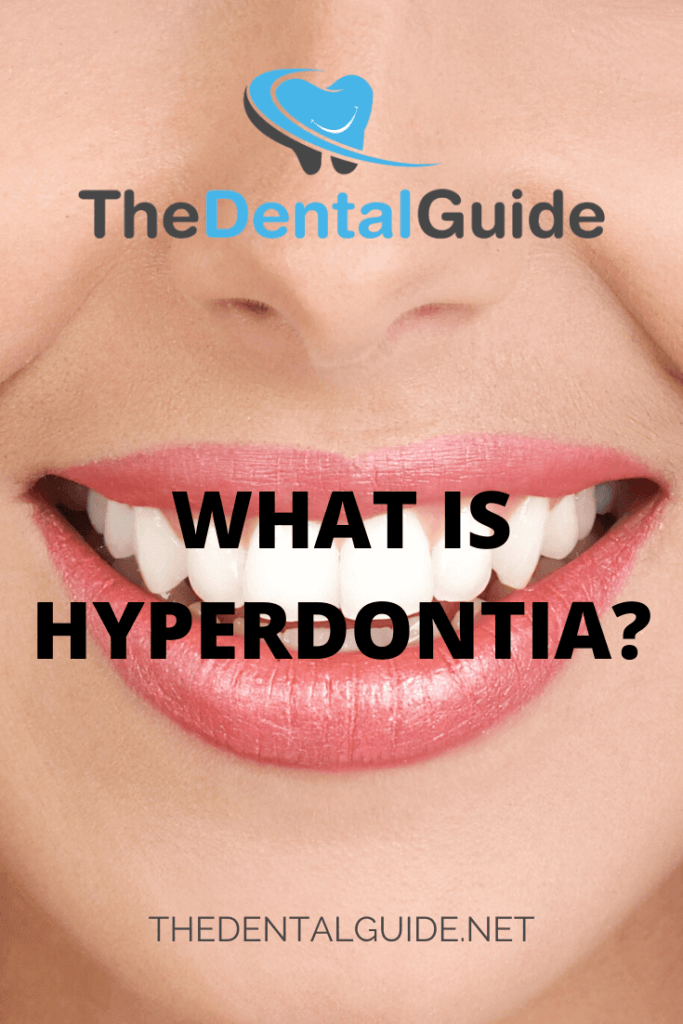Hyperdontia is the formation of extra teeth inside the mouth. The extra teeth caused by this condition are called supernumerary teeth.
The number of primary teeth (baby teeth) that are generally present in humans is 20, and there are typically 32 permanent teeth (adult teeth).
With hyperdontia, extra teeth can grow anywhere in the dental arches – the curved areas of the mouth, where the jaw’s teeth attach.
The most common supernumerary teeth are primary anterior incisors in the upper arch.
Causes of Hyperdontia
It’s not known what causes hyperdontia, but it is known to more frequently accompany several conditions including:
- Gardner’s syndrome: a rare genetic condition characterized by cysts and growths on the skin, skull, and colon
- Ehlers-Danlos syndrome: a group of inherited conditions that cause connective tissue problems involving the joints, skin, spine, and muscles
- Fabry disease: a syndrome that causes an inability to sweat, sore hands and feet, a red or blue skin rash, and abdominal pain
- Cleft palate and lip: a split or opening in the upper lip or palate that is present from birth and can cause trouble swallowing, a nasal voice, and chronic ear infections
- Cleidocranial dysplasia: a condition that affects the healthy development of teeth and bones
Hyperdontia typically makes its appearance in adulthood, and it affects men twice as often as women. Supernumerary teeth usually grow directly behind or near the regular teeth.
Dentists categorize supernumerary teeth by their shape and location.
Shapes
- Supplemental teeth have a regular shape and look like the regular tooth next to them.
- Tuberculate teeth have a tubular or barrel-like shape.
- Compound odontoma teeth are a cluster of several small tooth-like growths.
- Complex odontoma is an area consisting of tooth-like tissue that is in a disordered group.
- Conical or peg-shaped teeth are sharp, have a broad base and are narrow at the top.
Location
- Paramolar teeth appear in the back of the mouth near a standard molar.
- Distomolar teeth grow in line with regular molars, instead of behind or around them.
- Mesiodens teeth grow in the maxillary midline, behind or in front of the incisors in the mouth. The most common location for extra teeth is this area.
Risks
Not all cases of hyperdontia require treatment, but there can be risks associated with having extra teeth.
If the presence of any supernumerary teeth causes any of these issues or has the potential to create these issues, treatment may be required:
- Delayed eruption of permanent teeth – Extra primary teeth can block the way for permanent teeth. They may be unable to push through and can even become impacted.
- Trouble chewing or pain when eating – Extra teeth in the mouth may cause problems with alignment and bite, which can make chewing difficult.
- Overcrowding of teeth – If the mouth is too small to accommodate the extra teeth, they can become crowded, causing pain and pressure.
- Inability to brush or floss properly – Because of the possibility of overcrowding and crooked teeth, it may not be easy to clean between them properly.
- Infection or gingivitis – Inability to clean the teeth thoroughly provides the perfect breeding ground for bacteria, which can lead to infections and gum disease.
- Development of cysts or tumours – Cyst and tumour formation is a rare but possible side effect of hyperdontia.
- Abnormal root formation nearby – Supernumerary teeth can occasionally cause resorption or deformation of the roots of nearby teeth.
Treatment
The presence of hyperdontia can cause functional and cosmetic problems. Even if extra teeth aren’t causing severe issues, some people may feel self-conscious and wish to have extra teeth removed.
Early identification of hyperdontia can prevent more severe issues from happening, so routine dental visits are essential for spotting any problems early. Dentists can see hyperdontia on an x-ray before it starts causing problems.
Most cases of hyperdontia only involve one extra tooth unless there are other underlying conditions responsible for the extra teeth. The only way to treat hyperdontia is by removing the extra teeth by extraction or surgery.
If the supernumerary tooth is partially or fully erupted, dentists can extract it under local or general anaesthetic. An oral surgeon will remove the tooth through surgery under general anaesthesia in the case of an impacted supernumerary tooth.
It’s possible to address malocclusion and alignment issues after the removal of the extra teeth. There are different options for orthodontic treatment for correcting mild to severe malocclusion and alignment issues.
